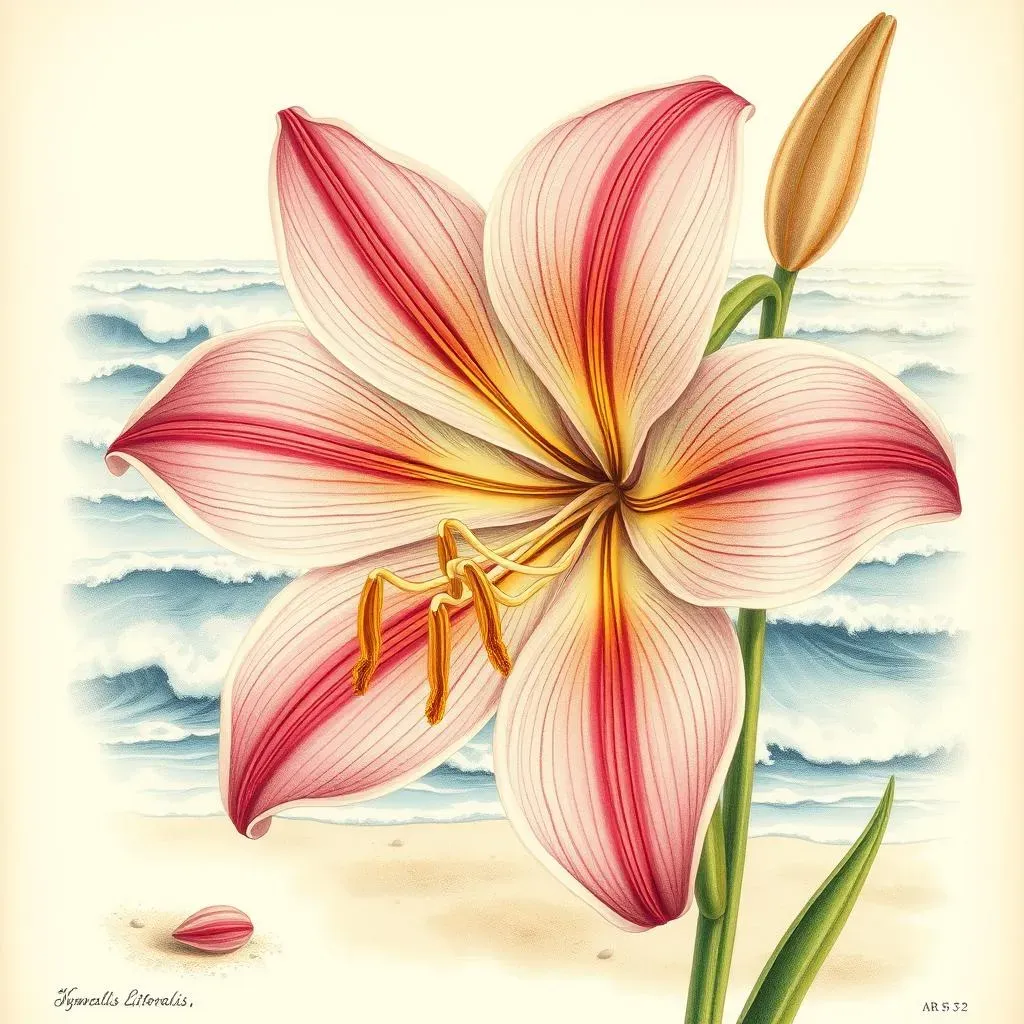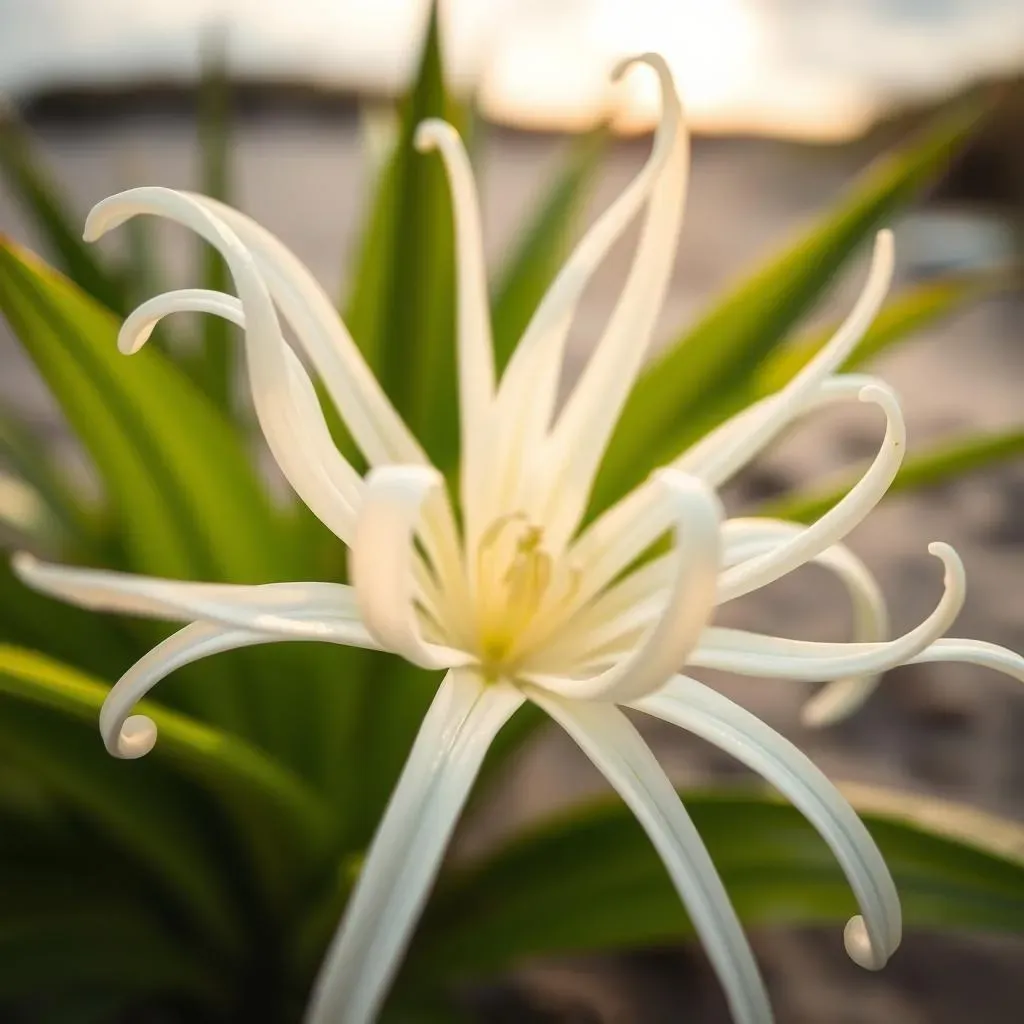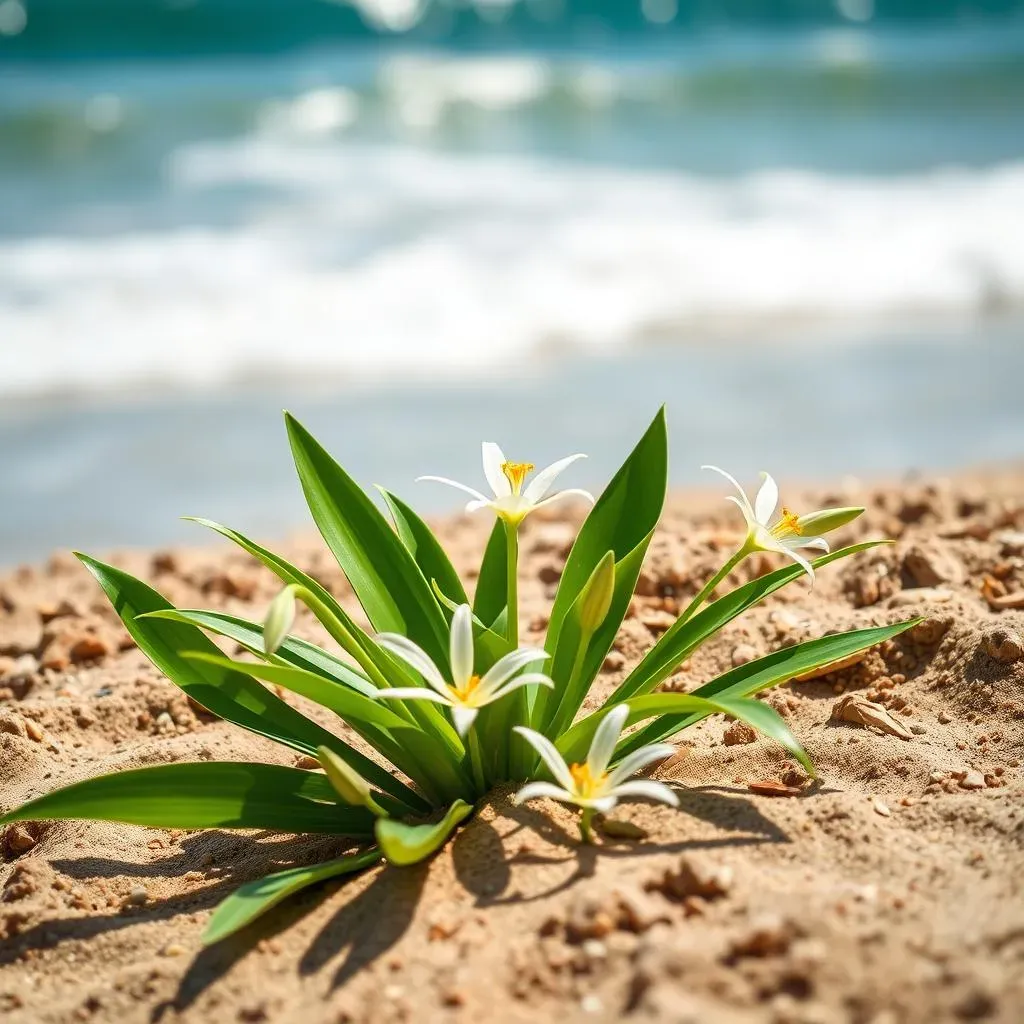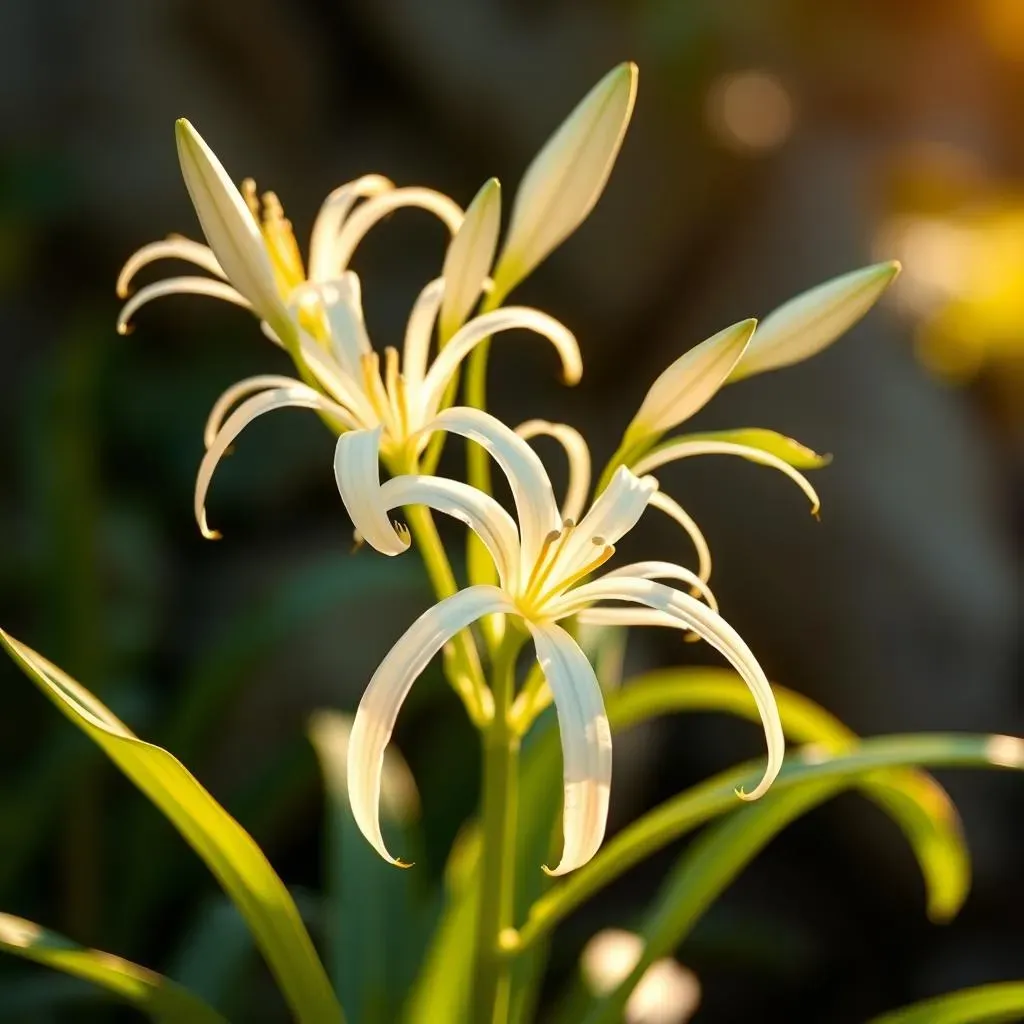Table of Contents
Ever seen a flower that looks like a delicate white spider dancing on a green stage? That's the beach spider lily flower, also known as Hymenocallis littoralis. This plant isn't your average garden variety; it's got a story, a unique look, and even some surprising secrets. We're about to embark on a journey to uncover all things beach spider lily. First, we'll explore how it got its fancy scientific name, Hymenocallis littoralis, and what it means. Then, we’ll take a close look at its striking appearance, from its long, strap-like leaves to its fragrant, spider-like blooms. We'll also talk about how to grow and care for your own beach spider lily. Beyond its beauty, this plant has some interesting uses, even in traditional medicine. Finally, we’ll see where this captivating flower calls home around the world. So, if you're curious about this fascinating flower, keep reading, and get ready to be amazed by the beach spider lily.
Decoding the Name: Hymenocallis littoralis

Decoding the Name: Hymenocallis littoralis
The 'Hymen' Part
Okay, let's break down this botanical mouthful, Hymenocallis littoralis. The first part, "Hymenocallis," comes from Greek. "Hymen" means membrane, and "kallos" means beauty. So, "Hymenocallis" basically translates to "membraned beauty." It's a pretty cool name, right? It refers to the delicate, almost see-through membrane that connects the stamens of the flower. Imagine a tiny, delicate veil within the flower, that's the "hymen" they're talking about. It's not something you'd notice at first glance, but it's what makes this flower unique.
'Littoralis' - Where it Grows
Now, the second part, "littoralis," is a bit more straightforward. It's a Latin word that means "growing by the seashore." This is a big clue about where this plant likes to hang out. It loves the coast! Think sandy beaches, salty air, and warm sunshine. That's where you'll find the beach spider lily thriving. It makes perfect sense, right? A flower named for its love of the beach! It's like it's saying, "I belong here, soaking up the sun and feeling the ocean breeze."
Word Part | Origin | Meaning |
|---|---|---|
Hymen | Greek | Membrane |
Kallos | Greek | Beauty |
Littoralis | Latin | Growing by the seashore |
Putting It All Together
So, when you put "Hymenocallis" and "littoralis" together, you get "membraned beauty growing by the seashore." Isn't that a fantastic name? It perfectly describes the flower and its preferred habitat. It’s like the botanists who named it were trying to tell its whole story in just two words. Next time you see a beach spider lily, remember its name and what it means. It's not just a pretty face; it's got a story woven into its very name. It's a little piece of nature's poetry.
Beach Spider Lily: A Closer Look

Beach Spider Lily: A Closer Look
Alright, let's really get into what makes the beach spider lily so special. First off, imagine a plant that's got these long, strap-like leaves. They're a deep, vibrant green and kind of remind me of thick ribbons. These leaves shoot up from the ground, creating a lush base for the real showstopper – the flowers. They're not your typical petals; they’re these large, white, spidery structures that seem to burst out from the center. Each bloom is like a tiny, intricate sculpture, with delicate, curved segments that give it that signature spider-like look. And the color? Pure, bright white, like a beacon against the green leaves. It's really something to see.
But it's not just about looks; these flowers also have a fantastic fragrance. It’s this sweet, vanilla-like scent that drifts on the breeze, especially in the evening. It's not overpowering, but it's definitely noticeable. When you get close, it's like a little secret perfume. The flowers themselves aren't huge individually, but they grow in clusters called umbels, which makes them seem even more impressive. Each umbel has about 4-6 flowers, all facing outwards, showing off their unique shape and color. They're like a little team of white spiders, all ready to catch your eye with their beauty and scent. They really stand out, especially against the backdrop of a beach or garden setting.
Feature | Description |
|---|---|
Leaves | Long, strap-like, deep green |
Flowers | Large, white, spider-like structures |
Fragrance | Sweet, vanilla-like scent |
Arrangement | Grows in clusters called umbels |
Cultivating the Beach Spider Lily

Cultivating the Beach Spider Lily
Sunlight and Soil
So, you wanna grow your own beach spider lily, huh? Well, first things first, these plants are sun-worshippers. They need a good dose of sunlight to really thrive. Think at least six hours a day. But, if you live somewhere with really intense afternoon sun, a bit of shade in the hottest part of the day can be a good idea. Now, about the soil – they're not too picky, but they do like well-draining soil. Imagine the sandy soil of a beach; that's what they're used to. If your soil is heavy or clay-like, you might want to mix in some sand or perlite to help with drainage. Nobody likes soggy roots, and beach spider lilies are no exception. It's like they're saying, "Give me sun and well-drained soil, and I'll be happy."
Watering and Feeding
Watering is another key part of keeping your beach spider lily happy. They like consistent moisture, especially when they're actively growing. But again, don't overdo it. You don't want them sitting in water. I usually check the soil by sticking my finger in it; if the top inch or so is dry, it's time to water. During the hotter months, you might need to water more often. As for feeding, a balanced liquid fertilizer during the growing season can give them a boost. It's like giving them a little vitamin shot. But don’t over feed them, follow the instructions on the fertilizer package. Too much fertilizer can sometimes do more harm than good. Think of it like this: they need enough to stay healthy, but not so much that they get spoiled.
Care Aspect | Requirement |
|---|---|
Sunlight | At least 6 hours daily, partial shade in intense heat |
Soil | Well-draining, sandy soil preferred |
Watering | Consistent moisture, avoid overwatering |
Fertilizing | Balanced liquid fertilizer during growing season |
Pruning and Propagation
When it comes to pruning, beach spider lilies are fairly low-maintenance. You can remove any dead or yellowing leaves as needed, and you can also cut off the flower stalks after the blooms have faded. This helps keep the plant looking tidy and also encourages more blooms. Now, if you want to expand your collection, you can propagate them by separating the offsets, which are little baby bulbs that grow around the base of the main bulb. It's like having a family of beach spider lilies! Just carefully dig up the plant, separate the offsets, and plant them in their own pots. It's a fun way to share these lovely plants with friends or just have more for yourself. They're not fussy, but a little care goes a long way with these beauties. It's like they're saying "Treat me well, and I'll show you my best."
Medicinal and Other Uses

Medicinal and Other Uses
Traditional Medicine
Okay, so here’s where it gets really interesting. Beyond just being a pretty face, the beach spider lily has a history of being used in traditional medicine. People in different parts of the world have used various parts of the plant for their potential healing properties. I'm talking about things like using the leaves or bulbs to create poultices for wound healing. Imagine, a plant that can help soothe cuts and scrapes! Some cultures have also used the plant to address other ailments, though it's important to note that these uses are based on traditional practices and haven't always been fully backed by modern science. It's like this plant has a secret life as a natural remedy, passed down through generations.
It's fascinating how different cultures have found ways to use plants for their well-being. It makes you think about how much knowledge is stored in these old traditions. While we should always approach these practices with caution and consult with healthcare professionals, it's still pretty cool to learn about the plant's history and its connection to people's health. This beach spider lily isn't just a beautiful flower, it’s also a bit of a natural pharmacy.
Other Uses and Research
But wait, there's more! The beach spider lily's story doesn't end with traditional medicine. Scientists have actually taken a closer look at this plant, and they've found some interesting things. Some studies have explored its potential for anti-viral and anti-neoplastic properties. That's a fancy way of saying they're looking into whether it could help fight viruses and cancer. It’s like this flower has hidden superpowers that we're just beginning to discover. Of course, this research is still in its early stages, and we need much more study to know the full potential of these findings. But it's exciting to think that this plant could have even more to offer.
Besides medical research, the beach spider lily is also valued for its ornamental qualities. It’s a popular choice for gardens and landscapes, especially in tropical and subtropical regions. Its striking white flowers and lush green leaves make it a real standout. Plus, it’s relatively easy to grow, which makes it even more appealing. So, whether you're looking for a beautiful addition to your garden or just curious about its medicinal uses, the beach spider lily has a lot to offer. It's not just a pretty face, it’s a plant with a story, a history, and a future.
Use | Description |
|---|---|
Traditional Medicine | Wound healing, other ailments (traditional practices) |
Scientific Research | Potential anti-viral and anti-neoplastic properties |
Ornamental | Popular in gardens and landscapes |
Beach Spider Lily Around the World

Beach Spider Lily Around the World
Native Shores and Beyond
Alright, let's talk about where the beach spider lily calls home. It's originally from the warmer coastal areas of Latin America, think places like Mexico, Central America, and parts of South America. Imagine those sunny, tropical beaches; that's where these beauties first sprouted. But, here's the thing, this plant is a bit of a traveler. It's been introduced and naturalized in many other tropical and subtropical countries around the globe. It's like it packed its bags and decided to see the world.
You'll find beach spider lilies thriving in places like the Caribbean, parts of Africa, and even some areas in Asia. They've adapted so well that in many of these places, they're considered part of the local flora. It’s kind of cool to think that a plant from Latin America is now happily growing in a garden in, say, Australia or Singapore. They really do seem to love a good coastal spot, wherever that may be. It's like they're saying, "As long as there's sun and a bit of sea breeze, I'm happy to grow here."
Naturalized and Cultivated
Now, when we say "naturalized," it means that the beach spider lily has successfully established itself in a new place and is growing without human help. It’s not just surviving; it’s thriving and reproducing. In many countries, you might see them growing along the coastlines, in parks, and even in people's gardens. They've become a common sight, like they've always been there. But, of course, they're also widely cultivated as ornamental plants. People love to plant them because of their beautiful flowers and sweet fragrance. It’s like having a little piece of the tropics in your backyard. They really do add a touch of elegance and exotic charm to any landscape.
Region | Status |
|---|---|
Latin America | Native |
Caribbean | Naturalized |
Parts of Africa | Naturalized |
Parts of Asia | Naturalized |
Australia | Naturalized and Cultivated |
Singapore | Naturalized and Cultivated |
A Global Traveler
The beach spider lily's journey around the world is a testament to its adaptability and beauty. It's a plant that has captured the hearts of people in many different cultures, and it continues to spread to new places. It’s like it’s on a never-ending adventure, finding new homes and charming everyone it meets. It's really amazing to think about how a single plant can have such a global reach. From its humble beginnings in Latin America to its current status as a beloved garden plant and a naturalized beauty in various corners of the earth, the beach spider lily's story is one of resilience and adaptability. It's not just a flower; it's a global citizen.
“The earth laughs in flowers.” – Ralph Waldo Emerson
References and Further Reading

References and Further Reading
Alright, so you've made it this far and you're probably thinking, "Where can I learn even more about this amazing beach spider lily?" Well, you're in luck, because there's a whole world of information out there! If you're looking for some solid scientific details, I'd recommend checking out resources like the Kew World Checklist of Selected Plant Families. They've got all the official botanical classifications and details. It's like the plant's official resume, if you will. And, of course, there are tons of great books and articles out there too. Just a quick search online will give you a bunch of leads. I always like to cross-reference my info from a few different sources, just to get a well-rounded view. It's like doing a bit of detective work, piecing together all the facts.
For a more hands-on approach, you could check out some local botanical gardens or nurseries that specialize in tropical plants. Often, they'll have experts who can answer your questions and share their own experiences with growing beach spider lilies. Plus, you get to see the plants up close and personal, which is always a good thing. Online forums and gardening communities can also be a goldmine of information. You can connect with other plant lovers, share your experiences, and get advice from people who have actually grown these plants themselves. It's like having a big group of plant buddies cheering you on. So, whether you're a scientist, a gardener, or just curious about this plant, there's something out there for everyone. Happy researching!
Resource Type | Example | Focus |
|---|---|---|
Botanical Databases | Kew World Checklist of Selected Plant Families | Scientific classifications, details |
Books and Articles | Various online sources | In-depth information |
Botanical Gardens | Local gardens | Expert advice, personal experiences |
Online Forums | Gardening communities | Practical tips, shared experiences |